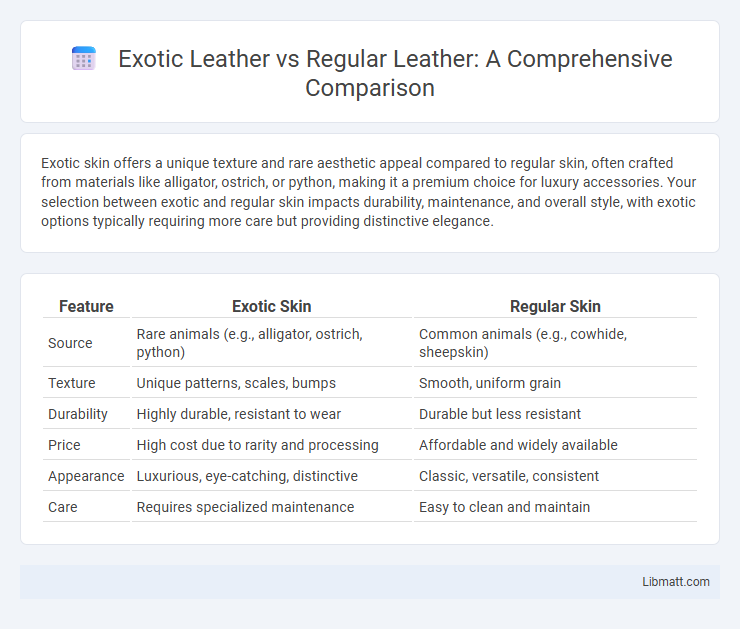Exotic skin offers a unique texture and rare aesthetic appeal compared to regular skin, often crafted from materials like alligator, ostrich, or python, making it a premium choice for luxury accessories. Your selection between exotic and regular skin impacts durability, maintenance, and overall style, with exotic options typically requiring more care but providing distinctive elegance.
Table of Comparison
| Feature | Exotic Skin | Regular Skin |
|---|---|---|
| Source | Rare animals (e.g., alligator, ostrich, python) | Common animals (e.g., cowhide, sheepskin) |
| Texture | Unique patterns, scales, bumps | Smooth, uniform grain |
| Durability | Highly durable, resistant to wear | Durable but less resistant |
| Price | High cost due to rarity and processing | Affordable and widely available |
| Appearance | Luxurious, eye-catching, distinctive | Classic, versatile, consistent |
| Care | Requires specialized maintenance | Easy to clean and maintain |
Understanding Exotic Skin and Regular Skin
Exotic skin, sourced from rare animals like snakes, alligators, and ostriches, offers unique textures and patterns that are highly prized in luxury fashion and accessories. Regular skin typically refers to more common leather from cows or pigs, known for durability and versatile use in everyday products. Understanding these differences helps you make informed choices based on texture, rarity, and application needs for your leather goods.
Key Differences Between Exotic and Regular Leathers
Exotic skin leather, sourced from rare animals like snakes, alligators, and ostriches, features unique textures and patterns compared to regular leather made from cowhide, offering higher durability and a distinctive aesthetic appeal. The tanning process for exotic skins often involves specialized techniques to preserve their natural scales, bumps, or pores, which regular leather lacks due to its smoother finish. Your choice between exotic and regular leather impacts cost, maintenance requirements, and visual exclusivity, making exotic skins a luxury option for high-end fashion and accessories.
Popular Types of Exotic Skins in Fashion
Popular types of exotic skins in fashion include alligator, python, ostrich, and stingray, each prized for its unique texture and durability. These materials offer a luxurious alternative to regular cowhide leather, with distinctive patterns and natural markings that enhance the visual appeal of handbags, shoes, and accessories. Your choice of exotic skin can elevate your style, providing a statement piece that combines exclusivity with craftsmanship.
Durability: Exotic Skin Versus Regular Leather
Exotic skins, such as alligator, ostrich, and python, exhibit superior durability compared to regular leather due to their dense fiber structure and natural resistance to wear and tear. Regular leather, derived from cowhide, tends to be more susceptible to scratches and may require more frequent conditioning to maintain its lifespan. The enhanced toughness of exotic skins makes them an ideal choice for high-end fashion accessories that demand longevity and resilience.
Price Comparison: Exotic Skin vs Regular Skin
Exotic skin products typically command significantly higher prices compared to regular skin due to rarity, intricate texture, and labor-intensive crafting processes. Items made from materials like alligator, python, or ostrich leather can cost several times more than those using standard cowhide or synthetic alternatives. Your investment in exotic skins reflects not only exclusivity but also superior durability and unique aesthetic appeal.
Ethical and Legal Considerations of Exotic Skins
Exotic skins, sourced from species like snakes, alligators, and ostriches, often raise complex ethical and legal concerns related to wildlife conservation and animal welfare laws. Regulatory bodies enforce strict permits and trade restrictions under agreements such as CITES (Convention on International Trade in Endangered Species) to prevent illegal poaching and trafficking. Your purchase of exotic skin products should prioritize transparency, proven sourcing, and compliance with international regulations to ensure ethical and legal integrity.
Maintenance and Care: Exotic vs Regular Leather
Exotic skin leather, such as crocodile, python, or ostrich, requires specialized maintenance involving gentle cleaning with specific leather conditioners and avoiding prolonged exposure to moisture and direct sunlight to prevent damage and preserve its unique texture. Regular leather is generally more durable and easier to care for, often only needing routine cleaning with mild soap and leather conditioner to maintain suppleness and prevent cracking. Your choice between exotic and regular leather should consider the commitment to their distinct care routines to ensure longevity and retain their aesthetic qualities.
Fashion Trends: Exotic Skin Applications
Exotic skin applications in fashion trends highlight the use of materials like snakeskin, alligator, and ostrich, offering unique textures and high durability compared to regular leather. These skins are favored for luxury handbags, shoes, and accessories, elevating your style with distinct patterns and a high-end appeal. The increasing demand for sustainable and ethically sourced exotic skins is shaping future fashion movements toward responsible luxury.
Sustainability Issues in Leather Production
Exotic skin leather, sourced from animals like alligators, snakes, and ostriches, often involves complex sourcing practices that can raise significant sustainability concerns due to habitat disruption and endangered species risks. Regular leather, typically derived from cattle, contributes to deforestation, high water consumption, and methane emissions, making its production environmentally intensive. Innovations in sustainable tanning methods and the adoption of regulated farming practices are critical to mitigating the environmental impact of both exotic and regular leather industries.
Choosing Between Exotic and Regular Skin Products
Exotic skin products often contain rare ingredients like snake venom, pearl powder, or caviar extract, delivering intense hydration and anti-aging benefits that regular skin products may lack. These premium formulations target specific concerns such as hyperpigmentation and fine lines with higher concentrations of active compounds, making them suitable for users seeking luxury skincare experiences. Regular skin products prioritize accessibility and everyday maintenance, providing essential cleansing, moisturizing, and protection with widely studied ingredients like hyaluronic acid, retinol, and vitamin C.
Exotic skin vs regular skin Infographic

 libmatt.com
libmatt.com